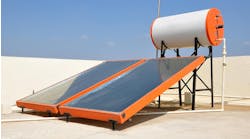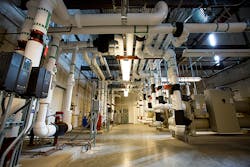Latest from Solar
Sponsored
Delta force: team makes company HQ a green technology showcase
FREMONT, CALIF. — When the people at Delta Americas realized the company was rapidly outgrowing its headquarters building in Fremont, Calif., a 15-acre parcel of land right down the street seemed like the ideal location for a new construction project. The company, which manufactures energy-efficiency products, had some lofty goals in mind for its new headquarters.
Mike Gazzano, marketing manager for Delta Americas, noted that green building was the number one priority for the facility, which was designed to achieve LEED Platinum status and be a net-zero building.
“In the Delta culture, ever since 2006, our founder and honorary chairman, Bruce Cheng, has mentioned that any new Delta facility worldwide needs to conform to green building standards,” Gazzano said. “So when we found out about this piece of property here it made sense to start from the ground up.”
The resulting state-of-the-art building features a geothermal heating and cooling system with bi-directional radiant tubing embedded in the concrete slabs, as well as active chilled beams in the conference rooms. Other high-efficiency systems include cutting–edge plumbing fixtures, solar panels on the rooftop, and LED lighting. The building also features a 140,000-gal. rainwater harvesting system for irrigation and charging stations for electric vehicles in the parking lot.
A conscious effort was made to showcase Delta’s own products, including the company’s photovoltaic inverters, energy-saving variable frequency drives, electric charging stations and wireless outdoor LED lights.
The two architecture firms on the project were J.J. Pan and Partners of Taiwan and K.S.H. Architects of San Francisco. Joshua Pan, principal at J.J. Pan and Partners, summed up the project’s main objective this way: “The key design goal was simple: design the most sustainable building and deliver it in the most efficient method possible.”
It took a talented team of architects and design-build contractors to make it happen. Construction professionals on the project included general contractor Vance Brown Builders of Palo Alto, Calif.; HVAC contractor ACCO Engineered Systems of Glendale, Calif.; and plumbing contractor KDS Plumbing of San Jose, Calif.
Cutting-edge heating, cooling
Jonathan Bell, a 16-year veteran with ACCO Engineered Systems, shared his insights on the design and installation of the heating and cooling system. ACCO is a design-build mechanical contractor whose core business includes HVAC, plumbing, process piping, controls and service. The initial proposal developed by Timmons Engineering Group was right in Bell’s wheelhouse.
“The design was really driven by what we think the most energy-efficient system would be, and that ended up being the radiant system with some natural ventilation,” he said. “It was very similar to a project I had done for Stanford University. I had a pretty good idea of what they were trying to achieve.”
Bell realized that he would have to educate the building owners on the way the in-slab radiant system would perform, and he took them on a tour of the Stanford University building.
“One of the big challenges was for me to let Delta know what they are getting, because this is a cutting-edge building and it’s not going to perform like 98 percent of the other office buildings they’ve ever been in,” he said. “My challenge was to educate them on not only the cost, but how it’s going to perform and what’s different about it. It’s important that they knew that before they pulled the trigger and got into something like this.”
He explained that the radiant system couldn’t react as quickly as a forced-air system to change the temperature.
“The other element was that the building used natural ventilation, so occupants have to be aware of how their actions might affect their neighbors,” he said. “It also changes the way you run the building. If you know that you are going to have a week of 100-degree weather, you should be taking steps to pre-cool the building at night, for example. So those are the big challenges, but they liked the idea and they bought into it.””
The heart of the facility’s geothermal heating and cooling system is a large central plant with two heat pump chillers from Daiken McQuay. They are connected to a field of 3-in. HDPE pipe installed underground on the site and to the Uponor HE Pex piping that constitutes the radiant tubing in the slabs. In all, the company estimates are there are more than 92 miles of pipe circulating 12,000 gallons of water.
The radiant system works well with the building’s open floor plan, but active chilled beams were installed to quickly cool conference rooms, where a group of occupants could cause the temperature to rise quickly.
Two air handlers manufactured by Energy Labs provide 100 percent outdoor air to ventilate the building. They are one-third the size of what they would need to be with a forced-air system building of this size of building, as they only have to provide air for ventilation. The air handlers also include heat pipe energy recovery coils between the supply air and relief air streams that recover energy to pre-heat or pre-cool the outside air as it enters the building.
The geothermal system was designed by Terry Proffer of Major Heating and Geothermal out of Denver.
“It was our role to work on it with him, build the header and connect the pipes,” Bell said. “There was quite a bit of back and forth between us and the geothermal designer to get the system sized right. We had to do a full building heating and cooling load profile model, hour by hour, throughout the year for Terry to properly size the geothermal field.”
Challenging installation
Bell characterized the biggest challenge on the project as the installation and sequencing of the radiant tubing within the slabs.
“We’re embedding our heating and cooling system into the structural elements of the building, so first of all we have to design it right,” he said.
ACCO has to design and install three different types of slabs. The slab on grade was insulated below the tubing, as they didn’t want to lose energy into the ground. For the intermediate floors, the slabs were designed to radiate in both directions, heating or cooling both the floor above and the floor below. Radiant tubing was also installed on the roof, where insulation was applied on top of the tubing.
For large areas, Uponor’s radiant rollout mats were used to speed installation.
“They manufacture a roll of circuits, so we’d get these nice, giant rolls that are all labeled and tagged for the circuit they go in. You just slip off the strings that are holding it together and roll it out.”
ACCO worked with Uponor to design the roll out mats.
“We asked them to provide attachment strips three feet on center so we could staple them to the concrete as we rolled them out, so there were no problems with them re-rolling back up or floating out,” Bell noted. “It worked out quite well. The rollout mats for large areas were a big time saver.”
The coordination of the concrete pours was crucial, and once the pours were completed, the system had to be protected from damage caused by other workers.
“Other tradesmen might not even know there was a system in there,” Bell pointed out. “It’s a continuous education process. We have to tell people there is a system of tubes in there, so if you’re going to core it or drill through it, you have to talk to somebody before you drill.”
There were also some challenges with the design of the geothermal system. The city imposed some restrictions because the site was close to a protected wetland area.
“The city of Freemont was not very thrilled that we would be drilling down 200 or 300 feet and how that might affect this protected environment,” Bell said. “We ended up with a horizontal layout that was much more spread out. There were two layers that were installed using a directional boring machine. One layer was about 15-feet deep, and the other about 30-ft. deep.” The shallower drilling depths allayed the concerns of the city, and the site was large enough to accommodate the revised design.
High-efficiency plumbing
Sandy Salamon, president of KDS Plumbing in San Jose, Calif., was tapped as the plumbing contractor on the project. The scope of work for the included removing the water from the roof, and KDS designed and installed the roof drains and backup overflow.
“We brought the water down from the roof down to five feet outside the building so they could connect it to the outside storage system,” he said. “The tanks were installed by others.”
KDS provided the sanitary sewer and vent for the bathroom course, the break room sinks, and the drains in the mechanical room. The company also provided domestic hot water and potable cold water to the bathrooms and sinks throughout the building.
“The tough thing in a building this large is the suspended piping has to be coordinated,” Salamon said. “It has to meet the architect’s vision of whether the pipe can be seen or not seen. There is some storm piping hung in the ceiling because it could only exit on one side of the building, so it required some big pipe and a lot of hung pipe.”
High-tech plumbing fixtures also contributed to the building’s LEED Platinum status.
“Of course we used low-flow devices,” Salamon said. “The toilets were 1.28-gallon per flush; the urinals were one-eighth gallon, or so-called pint flush; and the faucets were down to 0.17 gallons per minute. All of those items led to at least a 40 percent water savings.”
The toilets were manufactured by American Standard. The Sloan automatic faucets in the bathroom feature a solar panel that charges the lithium battery when the lights are on. High-efficiency electric water heaters from A.O. Smith also contribute to the building’s energy efficiency.
“They were installed close to the area of use, so we did not waste energy running water for distribution,” Salamon said.
According to Salamon, they key to the smooth installation was proper advance planning and seamless execution by his crew of union workers.
“It was a great team to work with,” Salamon said. “Most plumbing design is straightforward as long as things are established up front. Utilities have to leave the building and you have to connect to public utilities, so those were coordinated and they were established. Once that was done, it was a race to take care of the inside. We met with K.S.H. Architects to determine the lines were in the right columns and right locations. Once all of those guidelines were perfected and agreed on, the plumbers just connected the dots.”
Delta Americas announced the official opening of their new headquarters in October of 2015. According to Gazzano, employees are thrilled with their new offices and feedback on the building has been overwhelmingly positive.
“It’s great to work in such a lovely, green building and know we walk the walk and talk the talk here when it comes to green philosophy,” Gazzano said. “Our overall company mission statement is to provide innovative, clean and energy-efficient solutions for a better tomorrow, and we’ve certainly achieved that here in our new Delta Americas headquarters.”
Bell and Salamon both look back on the experience with pride. “It was an outstanding project and I’m thrilled to have been a part of it,” said Bell. “I have a feeling I’ll be out there quite a bit, walking engineers and architects through that building.”
Christopher King is a writer and editor who has covered the construction industry for more than 15 years. He previously served as editor of Roofing Contractor, managing editor of the Air Conditioning, Heating & Refrigeration News, and associate editor of Plumbing & Mechanical. He can be reached at [email protected].





